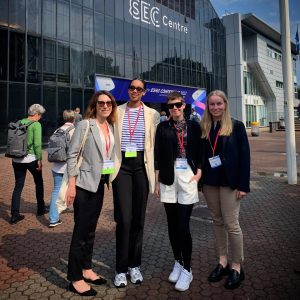Hi, we are Rafaela, Victoria, and Johanna, and we are all recipients of the HiLIFE conference grant. In June, we travelled to Glasgow, UK to attend the European Society of Human Genetics conference.

We are all students of Marco Savarese’s lab (Folkhälsan Research Center) studying genotype-phenotype correlations in rare inherited muscle diseases. Thus, ESHG was a great opportunity for us to learn about the newest, most cutting-edge research in genetics, and to start building connections in the field.
This was the first international scientific conference experience for all of us, and thus it was an extremely valuable opportunity to gain professional experience in networking, poster presenting, and scientific discussion, early on in our careers.
The conference offered special opportunities for newer members of the human genetics community, including events organized by ESHG Young Geneticist Committee (ESHG-Y). As first-time attendees, their events and workshops felt extremely helpful and informative and provided excellent opportunities to connect with our peers.
Overall, human genetics is a broad topic, which was reflected in the wide variety of research topics covered at the conference. Some of the reoccurring topics included AI-based solutions for variant interpretation, variant classification methods, and multiomics applications in genetics research. We wanted to highlight a few topics that we found most interesting and relevant in our work with rare genetic muscular diseases.
Artificial intelligence-based solutions in human genetics
Implementing AI based solutions is a hot topic in genetics, and many of the conference presentations reflected this excitement. Among the most interesting ones were a talk about the Eye2gene project and a poster about the Gestaltmatcher database.
The Eye2gene project was inspired by clinicians diagnosing inherited retinal disease from eye scans. The disease causes specific patterns of damage to the eye. For the clinicians, it takes years of experience to be able to recognize these patterns. Thus, there are few doctors capable of reaching such diagnosis, causing delays in patient care. The Eye2gene method uses AI to interpret these eye scans, and the results show reliable performance. This method could not only speed up diagnosis but also reduce human error and variability of analysis from clinician to clinician, making the diagnosis more precise.
In relation to our work with rare muscular diseases, the Eye2gene project is a great example of how improved understanding of the phenotype can aid with understanding the genetic background of the diseases as well. Although this approach would probably be much more difficult to implement in MRI imaging used in muscular diseases, it is an intriguing potential future application.
The Gestaltmatcher is a similar AI-based approach to medical imaging analysis. This database allows an authorized user to upload medical images associated with rare diseases. The AI of the database groups similar images together to find groups of patients with common phenotypes. A major challenge in rare genetic diseases is often the small number of patients. Thus, it is extremely valuable to be able to share data and to gather a database as large as possible from the limited number of patients with a similar phenotype. Larger databases allow for better understanding of the disease phenotype and the genetic background of the disease, and ultimately, to develop treatments for even the rarest of genetic diseases.
Gestaltmatcher showed that AI has an enormous potential in assisting clinicians and researchers in pattern detection in patient cohorts. This is an asset we should consider taking advantage of in our group’s muscle disease patient cohorts to better understand genotype-phenotype relationships in these diseases.
Improved sequencing methods and multiomics approaches
Multiomics approaches were a reoccurring topic at ESHG and it was featured in several presentations and posters throughout the event. In the context of genetics, the term multiomics generally refers to the practice of combining genomics, transcriptomics, proteomics, and sometimes epigenomics. Multiomics has many applications: it can be used for interpretation of variant pathogenicity or to uncover novel disease-causing variants, for example. A presentation at the conference revealed a method of combining genome sequencing with proteomics data to help uncover novel causative variants or reach a final classification for variants of uncertain significance. Epigenomic and transcriptomic approaches were also featured.
The use of newer, more advanced sequencing approaches, such as long-read sequencing, is also growing rapidly, with regards to both DNA and RNA. In particular, targeted long-read sequencing is being used to diagnose specific diseases since it includes only genes that have a known association with a disease, making it cheaper than whole genome long-read sequencing, but more accurate and precise than traditional gene panels.
The presentations at the conference clearly emphasized the advantages of multiomics approaches and new sequencing methods. Clearly, these are growing topics in human genetics, and thus, it was useful to hear stories of how these methods have been implemented in practice. This helps us to start developing an understanding of how these methods could be most effectively implemented in the context of muscular diseases.

This conference experience allowed us to learn about many new topics and to broaden our understanding of human genetics. It was inspiring to hear about the outstanding research and the future of genetics. This trip left us inspired and even more excited and motivated to continue working on our projects with newly developed skills, knowledge, and connections. On top of that, we had a wonderful time together in sunny Glasgow.
We would like to thank HiLIFE for making this trip possible!
